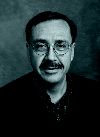
The Berkeley team made their observations using an "integrated laser trap/flow control video microscope" which was designed and built in Bustamanteís laboratory. In this set up, a strand of DNA is tethered between two micron-sized polystyrene beads in the middle of a chamber, one bead anchored on the tip of a glass pipette and the other held by a laser beam in an optical trap. Controlling the exchange and flow of liquids through the chamber and manipulating the laser trap can then be used to apply force on the beads and the results can be measured through video microscopy.
This unique experimental system enabled the researchers to make direct observations of the RNAP transcription process in real-time over a long length of DNA (more than a thousand base-pairs). Their spatial and temporal resolution was better than previous efforts, and they could record transcription events not only as a product of solution conditions but also as a function of applied force.
It was known that RNAP may pause during the transcription process at various points along the way for a few seconds or a few minutes. Transcription may even stop entirely, with the RNAP going into a state of arrest. In their Science paper, the Berkeley researchers reported that the rate at which RNAP transcription took place would vary but the variations were not associated with specific locations along the DNA. Rather, individual RNAP molecules would switch back and forth from transcribing at a faster or slower rate, as if, Bustamante says, "they exist in different gears corresponding to different functional or dynamic states."†
The team also observed that RNAP molecules transcribing at a faster
rate are less likely to pause than those transcribing at a slower rate.
The authors said this suggested a "kinetic competition" between transcription
and pausing. This would mean that pauses are not intermediate steps in the
transcriptional process but are a separate functional state that renders
the molecule incapable of further transcribing.
CARLOS
BUSTAMANTE
![]()

His
"movies" of DNA-binding molecules in action may not be
a threat to break Titanicís box office records,
but they draw rave reviews from scientists in his field.
Carlos Bustamante heads the Advanced Microscopies Department
for Berkeley Labís Physical Biosciences Division and is
also a Howard Hughes Medical Institute Professor of Biochemistry
and Molecular Biology at UC Berkeley. He has become an
international leader in developing methods of single-molecule
manipulation and capturing the dynamics on video.
![]()
Explains Bustamante, "Our observations were consistent with the idea that a paused RNAP molecule is not just stopped there, like at a traffic light, but has parked inside a garage and must be brought out of the garage to resume its movement."
Bustamante and his colleagues speculated that within a cell there may be other molecules that bind to the RNAP to stabilize its conformation so that it transcribes at a faster or slower rate which in turn would make it more or less susceptible to pausing. This, they suspected, could be the basis for yet another level of transcriptional control and regulation. Future experiments are planned using an improved second generation version of the integrated laser trap/flow control video microscope.
Coauthoring the Science paper with Bustamante were John Davenport and Gijs Wuite with UC Berkeley, and Robert Landick with the University of Wisconsin at Madison.† — Lynn Yarris
|
Next > | |||